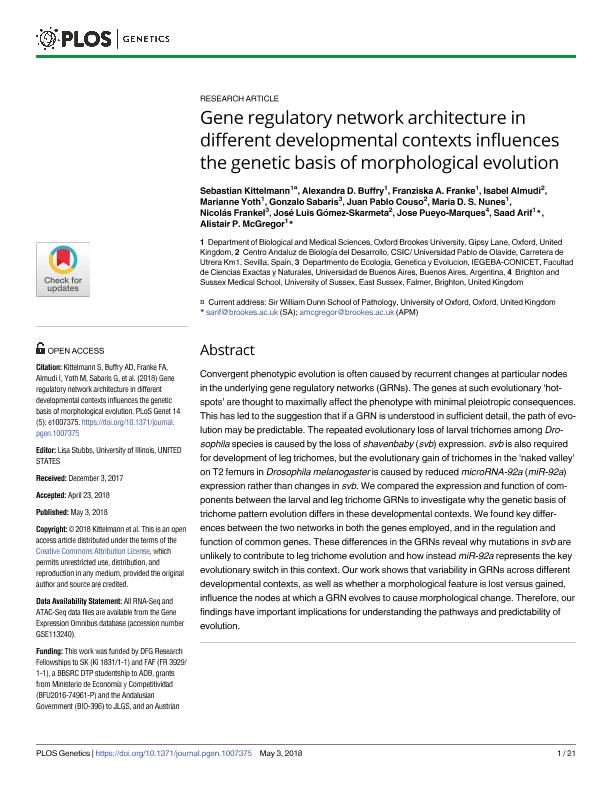Mostrar el registro sencillo del ítem
dc.contributor.author
Kittelmann, Sebastian
dc.contributor.author
Buffry, Alexandra D.
dc.contributor.author
Franke, Franziska A.
dc.contributor.author
Almudi, Isabel
dc.contributor.author
Yoth, Marianne
dc.contributor.author
Sabarís Di Lorenzo, Gonzalo Julián

dc.contributor.author
Couso, Juan Pablo
dc.contributor.author
Nunes, Maria D. S.
dc.contributor.author
Frankel, Nicolás

dc.contributor.author
Gómez-Skarmeta, José Luis
dc.contributor.author
Pueyo-Marques, Jose
dc.contributor.author
Arif, Saad
dc.contributor.author
McGregor, Alistair P.
dc.date.available
2019-10-15T21:33:16Z
dc.date.issued
2018-05-03
dc.identifier.citation
Kittelmann, Sebastian; Buffry, Alexandra D.; Franke, Franziska A.; Almudi, Isabel; Yoth, Marianne; et al.; Gene regulatory network architecture in different developmental contexts influences the genetic basis of morphological evolution; Public Library of Science; Plos Genetics; 14; 5; 3-5-2018; 1-21
dc.identifier.issn
1553-7390
dc.identifier.uri
http://hdl.handle.net/11336/85990
dc.description.abstract
Convergent phenotypic evolution is often caused by recurrent changes at particular nodes in the underlying gene regulatory networks (GRNs). The genes at such evolutionary ?hotspots? are thought to maximally affect the phenotype with minimal pleiotropic consequences. This has led to the suggestion that if a GRN is understood in sufficient detail, the path of evolution may be predictable. The repeated evolutionary loss of larval trichomes among Drosophila species is caused by the loss of shavenbaby (svb) expression. svb is also required for development of leg trichomes, but the evolutionary gain of trichomes in the ?naked valley? on T2 femurs in Drosophila melanogaster is caused by reduced microRNA-92a (miR-92a) expression rather than changes in svb. We compared the expression and function of components between the larval and leg trichome GRNs to investigate why the genetic basis of trichome pattern evolution differs in these developmental contexts. We found key differences between the two networks in both the genes employed, and in the regulation and function of common genes. These differences in the GRNs reveal why mutations in svb are unlikely to contribute to leg trichome evolution and how instead miR-92a represents the key evolutionary switch in this context. Our work shows that variability in GRNs across different developmental contexts, as well as whether a morphological feature is lost versus gained, influence the nodes at which a GRN evolves to cause morphological change. Therefore, our findings have important implications for understanding the pathways and predictability of evolution.
dc.format
application/pdf
dc.language.iso
eng
dc.publisher
Public Library of Science

dc.rights
info:eu-repo/semantics/openAccess
dc.rights.uri
https://creativecommons.org/licenses/by-nc-sa/2.5/ar/
dc.subject
causas genéticas
dc.subject
diversidad orgánica
dc.subject.classification
Genética y Herencia

dc.subject.classification
Ciencias Biológicas

dc.subject.classification
CIENCIAS NATURALES Y EXACTAS

dc.title
Gene regulatory network architecture in different developmental contexts influences the genetic basis of morphological evolution
dc.type
info:eu-repo/semantics/article
dc.type
info:ar-repo/semantics/artículo
dc.type
info:eu-repo/semantics/publishedVersion
dc.date.updated
2019-10-09T20:45:16Z
dc.journal.volume
14
dc.journal.number
5
dc.journal.pagination
1-21
dc.journal.pais
Estados Unidos

dc.journal.ciudad
San Francisco
dc.description.fil
Fil: Kittelmann, Sebastian. Oxford Brookes University; Reino Unido
dc.description.fil
Fil: Buffry, Alexandra D.. Oxford Brookes University; Reino Unido
dc.description.fil
Fil: Franke, Franziska A.. Oxford Brookes University; Reino Unido
dc.description.fil
Fil: Almudi, Isabel. Universidad Pablo de Olavide; España
dc.description.fil
Fil: Yoth, Marianne. Oxford Brookes University; Reino Unido
dc.description.fil
Fil: Sabarís Di Lorenzo, Gonzalo Julián. Consejo Nacional de Investigaciones Científicas y Técnicas. Oficina de Coordinación Administrativa Ciudad Universitaria. Instituto de Ecología, Genética y Evolución de Buenos Aires. Universidad de Buenos Aires. Facultad de Ciencias Exactas y Naturales. Instituto de Ecología, Genética y Evolución de Buenos Aires; Argentina
dc.description.fil
Fil: Couso, Juan Pablo. Universidad Pablo de Olavide; España
dc.description.fil
Fil: Nunes, Maria D. S.. Oxford Brookes University; Reino Unido
dc.description.fil
Fil: Frankel, Nicolás. Consejo Nacional de Investigaciones Científicas y Técnicas. Oficina de Coordinación Administrativa Ciudad Universitaria. Instituto de Ecología, Genética y Evolución de Buenos Aires. Universidad de Buenos Aires. Facultad de Ciencias Exactas y Naturales. Instituto de Ecología, Genética y Evolución de Buenos Aires; Argentina
dc.description.fil
Fil: Gómez-Skarmeta, José Luis. Universidad Pablo de Olavide; España
dc.description.fil
Fil: Pueyo-Marques, Jose. University of Sussex; Reino Unido
dc.description.fil
Fil: Arif, Saad. Oxford Brookes University; Reino Unido
dc.description.fil
Fil: McGregor, Alistair P.. Oxford Brookes University; Reino Unido
dc.journal.title
Plos Genetics

dc.relation.alternativeid
info:eu-repo/semantics/altIdentifier/url/http://dx.plos.org/10.1371/journal.pgen.1007375
dc.relation.alternativeid
info:eu-repo/semantics/altIdentifier/doi/http://dx.doi.org/10.1371/journal.pgen.1007375
Archivos asociados
